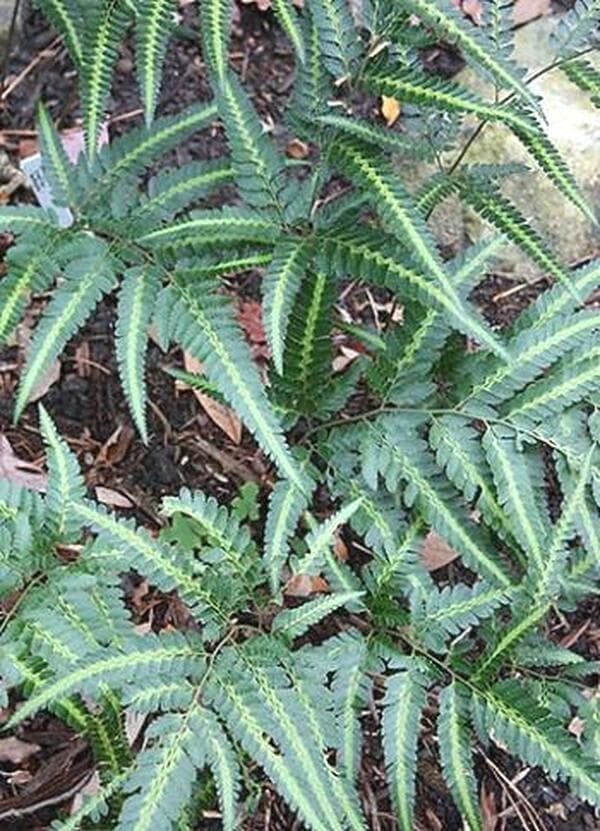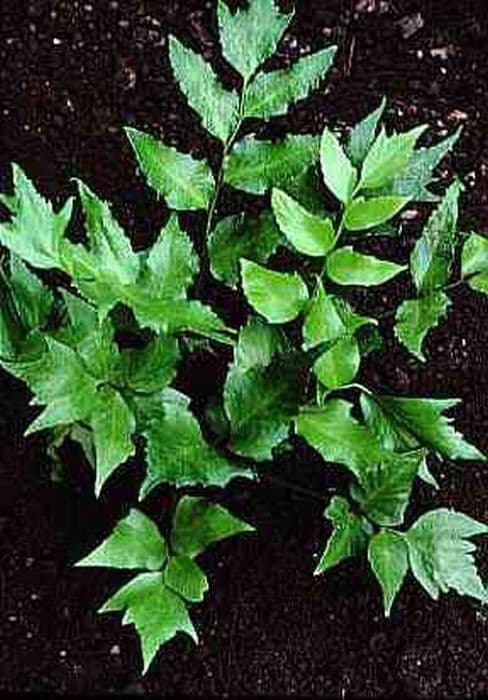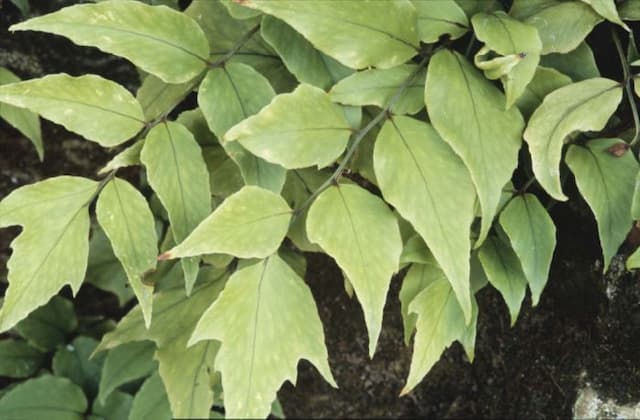Soft shield fern Polystichum setiferum (Divisilobum Group) 'Herrenhausen'











ABOUT
The Polystichum setiferum, or more commonly known as Soft Shield Fern, 'Herrenhausen', boasts a delicate and lacy appearance that brings a touch of elegance to any garden setting. Its fronds are finely divided, giving them a soft, feathery texture that appeals to the touch and sight. The foliage color is a lush, deep green that adds a sense of depth and vibrancy. The individual leaflets are intricately cut, and their arrangement on the stem is somewhat layered, creating a visually interesting structure that adds dimension to the plant's overall form. The leaflets often have overlapping qualities and may curl slightly at the edges, further enhancing their delicate aesthetic. The stems, which hold the leafy fronds, are sturdy yet unobtrusive, allowing the fronds to take center stage. This fern variety has a graceful, arching habit, with its fronds emerging from a central point and cascading outward, creating a vase-like shape that is both soothing and inviting in appearance.
About this plant
 Names
NamesFamily
Dryopteridaceae
Synonyms
Soft Shield Fern, Herrenhausen Fern
Common names
Polystichum setiferum 'Herrenhausen'
 Toxicity
ToxicityTo humans
The Soft Shield Fern (Polystichum setiferum) is generally considered non-toxic to humans. There are no common symptoms of poisoning because it is not known to be poisonous. Hence, ingesting parts of this fern does not typically result in toxic consequences.
To pets
The Soft Shield Fern (Polystichum setiferum) is also non-toxic to pets. It should not cause poisoning if a pet ingests it, and there are no known toxic consequences associated with its ingestion by animals such as cats and dogs.
 Characteristics
CharacteristicsLife cycle
Perennials
Foliage type
Evergreen
Color of leaves
Green
Height
3-4 feet (0.9-1.2 meters)
Spread
2-3 feet (0.6-0.9 meters)
Plant type
Fern
Hardiness zones
5-9
Native area
Europe
Benefits
 General Benefits
General Benefits- Aesthetic Appeal: Adds a lush, feathery texture to the garden with its finely divided, soft green fronds.
- Shade Tolerance: Thrives in shaded areas where other plants may struggle, making it ideal for woodland gardens or shaded borders.
- Low Maintenance: Requires minimal care once established, is drought-resistant, and generally does not need frequent watering or fertilizing.
- Evergreen: Maintains its foliage year-round, providing continuous visual interest even in winter.
- Erosion Control: Its root system helps stabilize soil on slopes, reducing erosion and supporting the soil structure.
- Habitat Support: Offers habitat and food for wildlife, such as shelter for small animals and insects.
- Ground Cover: Dense growth habit can help suppress weeds and cover bare spots in the landscape.
- Architectural Interest: The plant's structured form can be used to create visual interest in garden design, acting as a backdrop or focal point.
- Compatibility: Works well in combination with other shade-loving plants, including ferns, hostas, and heuchera, for a varied yet cohesive planting scheme.
 Medical Properties
Medical PropertiesThis plant is not used for medical purposes.
 Air-purifying Qualities
Air-purifying QualitiesThis plant is not specifically known for air purifying qualities.
 Other Uses
Other Uses- Textile Dyeing: The foliage of Soft Shield Fern can be used to produce natural dyes for textiles, giving fabrics a subtle green hue.
- Art and Craft: Leaves can be pressed or printed onto paper to create unique patterns for art projects.
- Culinary Garnish: Though not commonly consumed, the fronds can be used as an ornamental garnish for plating in high-end culinary presentations.
- Frost Protection: Soft Shield Ferns can be placed around temperature-sensitive plants to provide light frost protection due to their dense foliage.
- Soil Erosion Control: They can be planted on slopes or banks to help stabilize soil and prevent erosion with their extensive root systems.
- Theme Gardens: This fern can be a thematic feature in fairy or prehistoric-dinosaur-themed gardens due to its lush, ancient appearance.
- Biomimicry Design: The complex leaf patterns can inspire designs in architecture, clothing, and furniture for natural aesthetic appeal.
- Photography: Their intricate fronds and patterns make them an ideal subject for botanical photography and macro imagery.
- Education: Soft Shield Ferns can be used to teach about plant structure and the life cycle of ferns in educational settings.
- Humidity Indicator: In an indoor setting, the plant’s need for moisture can serve as a natural indicator for regulating indoor humidity levels.
Interesting Facts
 Feng Shui
Feng ShuiThe Soft Shield Fern is not used in Feng Shui practice.
 Zodiac Sign Compitability
Zodiac Sign CompitabilityThe Soft Shield Fern is not used in astrology practice.
 Plant Symbolism
Plant Symbolism- Endurance – Polystichum setiferum, commonly known as Soft Shield Fern, is an evergreen fern, representing the ability to endure and stay strong throughout the seasons, including the cold of winter.
- Protection – Ferns like the Soft Shield Fern are often associated with shelter and protection due to their dense foliage that can provide cover in a forest environment.
- Secretiveness – In Victorian floriography, ferns symbolized fascination, magic, and secret bonds of love because of their hidden reproductive parts and mysterious way of appearing in forests.
 Water
WaterSoft Shield Fern should be watered thoroughly but less frequently, allowing the top inch of soil to dry out between waterings. Depending on indoor conditions, this may equate to watering every 7 to 10 days with about half a gallon for an average-sized pot, with adjustments made for hotter, drier periods or cooler, damper seasons. Ensure water penetrates the soil fully without leaving the plant in standing water, which can lead to root rot. During the winter, reduce watering to prevent soggy soil, as growth slows and the plant requires less moisture.
 Light
LightSoft Shield Fern thrives in low to medium indirect light but can tolerate some shade, making it suitable for north-facing rooms or spots away from direct sunlight. It can also be placed near an east-facing window where it would receive some morning light but be protected from the harsh afternoon sun. Avoid placing it in areas with full, direct sunlight, as this may scorch the leaves.
 Temperature
TemperatureSoft Shield Fern prefers cool to moderate temperatures, thriving best between 55-75°F. It can survive brief periods outside this range but should not be exposed to temperatures below 50°F or above 80°F for extended periods. The ideal conditions are a consistent temperature that mimics its natural woodland habitat.
 Pruning
PruningPrune the Soft Shield Fern to remove dead or damaged fronds and to maintain its shape. This can be done any time of the year as needed, but the best time for a more thorough pruning is in early spring before new growth starts. Pruning will help encourage healthy new growth and keep the plant looking its best.
 Cleaning
CleaningAs needed
 Soil
SoilSoft Shield Fern thrives in moist, well-draining soil rich in organic matter. A mix composed of garden loam, leaf mold or compost, and some perlite or vermiculite would suit it well. The ideal soil pH for Soft Shield Fern should be slightly acidic to neutral, ranging from 5.5 to 7.0.
 Repotting
RepottingSoft Shield Ferns, being relatively slow-growing, do not require frequent repotting. It's typically sufficient to repot them every 3-4 years or when the plant has clearly outgrown its current container.
 Humidity & Misting
Humidity & MistingSoft Shield Fern prefers high humidity levels, ideally between 60% to 80%. Consistently high humidity helps mimic the plant's natural forest habitat and supports its lush, green fronds.
 Suitable locations
Suitable locationsIndoor
Place in shaded spot with high humidity.
Outdoor
Part shade, moist soil, sheltered location.
Hardiness zone
5-8 USDA
 Life cycle
Life cycleThe Soft Shield Fern 'Herrenhausen' starts its life cycle as spores, which are produced under the fronds on spore-bearing structures called sori. When conditions are right, the spores germinate and grow into a tiny, heart-shaped gametophyte, which is the sexual stage of the plant. The gametophyte produces sperm and eggs, which, after fertilization, develop into a new sporophyte - the familiar fern plant. This fern grows slowly, establishing a root system and fiddleheads that unfurl into the mature fronds, which can reach their full size within a growing season. The mature Soft Shield Fern 'Herrenhausen' will continue to produce new fronds each year from the center of the plant, where the older, outer fronds die back naturally. The plant can live for many years, continuing this cycle of growth and reproduction, providing it is in a suitable environment with shade, moisture, and well-drained soil.
 Propogation
PropogationPropogation time
Spring-Early Summer
The Soft Shield Fern (Polystichum setiferum Divisilobum Group 'Herrenhausen') is typically propagated by spores, which are usually ripe by late summer. However, the most popular method of propagation for this plant is by division, which is best done in early spring. To propagate by division, carefully dig up the fern, ensuring to keep as much root system intact as possible. The plant should then be gently pulled apart into smaller clumps, each having a section of crown and roots. These sections can be replanted at the same depth they were growing previously, in moist, well-drained soil. Water the newly planted divisions thoroughly to help establish them. This method allows gardeners to quickly increase their stock of the fern without waiting for spore germination.









